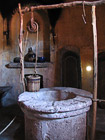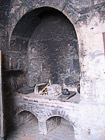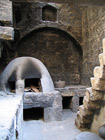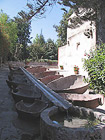The city of eternal spring Arequipa and wonderful valley Colca (page 2 of 4)
Irina Nazarova, Peru (January 2008)
|
page 1 <
» page 2 <
page 3 <
page 4 <
|
Nowadays, Arequipa with its population of 1 million is the second largest in population and importance city of Peru.
The main pearl of Arequipa is a convent Santa Catalina. It is real city within a city. If we were not restricted, as usual, in time we could have spent the whole day in the convent, but we had to allocate only four hours for it. But it was difficult to leave it, because when you enter the convent gates you, so to speak, cross the time threshold, and it is difficult to believe that behind the high walls there is the 21st century. Neither noise nor bustle of the city penetrate here, where you forget all the problems.
The convent was founded on September 10, 1579 on solicitation of doña Maria de Guzman, a rich widow, who donated all her wealth to it and has become the first nun and abbess under the name of Ana Maria de Jesus. Until the 17th century the territory of the convent extended and now the convent occupies more than 20000 sq.m. There used to be the times, when more than 400 women lived there almost without any contacts with outer world. Out of them less than a half were nuns, the rest were servants and girls adopted for bringing up and education. They say that nuns also gave refuge to run-aways who, due to various reasons, were hiding in the convent.
But only girls from rich families, who could donate to the convent quite a large sum at those times of 1000 silver peso and pay 100 peso for food were taken as lay sisters. Not only Creoles, but also métisses and even daughters of Indian chiefs – curacas were taken to the convent. And only in 1964 Spanish nuns appeared here.
In 1582 a devastating earthquake destroyed a considerable portion of structures and the nuns had to rebuild everything themselves.
The city dwellers did not imagine, what was going on behind high convent walls for 400 years and that gave birth to a lot of fantasies and legends.
In 1970 the Santa Catalina convent was opened for tourists. At present the nuns still live in the northern part of the complex. They are not many – not more than 30. It seems that now the life of nuns is not that much attractive for girls. The fact that the portion where the nuns live is designated on the detailed scheme of the convent as a «white spot» draws attention.
|
As it seemed to me the living conditions of the nuns are not that severe. The cells are for one, every nun has its own kitchen with a stove. But connection with the outer world was very much restricted. The nuns could receive visitors but the meetings were held in a patio where bars separated them from the world. Another nun had to be present during their talk.
|
 |
 |
 |
 |
The picturesque convent as the city in the whole is built, mainly, of tuff, but just a little portion of structures preserved its snow-white colour, for instance, where lay sisters used to live. The rest of the galleries are painted in blue, orange and red colours that gives the convent somewhat fairy-primitivistic appearance. The walls were painted because of two reasons. First – the tuff is better preserved. Second – to underline the beauty of decorative architectural elements, such as bás-reliefs, delicate stone carving, etc. I also heard from the guide explanation that in such a sunny city as Arequipa it is difficult to stay permanently in snow-white walls and those were painted so that the light did not irritate the eyes.
Six streets of that convent city bear the names of Spanish cities: Sevilla, Granada, Toledo, Malaga, Cordoba, Burgos. They join different yards, galleries, labyrinths. Numerous pots and little flower pots, carves wooden sun blinds and doors add to the impression. That is why a walk in the convent creates a cheerful and peaceful mood.
The convent is situated within a five minutes walk from Plaza de Armas («Square of Arms», central square), which Arequipeños, naturally, consider to be the most beautiful in the country, in the same way as a main cathedral. But because of frequent earthquakes, that sometimes used to completely destroy the city, the cathedral is not uniform. Built in 1621, after the earthquake of 1868 it was completely renovated. So the initial baroque was added by neo-classic.
«La Compania» is one of the few churches that practically did not suffer from earthquakes. Nobody knows when it was founded, there is date above the entrance 1698, but they think that some portions of that church of Jesuits appeared in 1654. Its facade refers to the best examples of mestizo Arequipa style. The church galleries also impress by the beauty of reliefs.
At Plaza de Armas we observed with curiosity the peaceful coexistence of different styles of life and priorities. It was on May 1, when the procession in honour of a local saint and May-Day demonstration with red flags and portraits of Che Guevara crossed in one square.
It is also worth seeing San Francisco abbey that was founded in 1569 but, because of numerous earthquakes, it was constantly rebuilt, however, trying to preserve the original concept. In the church of San Francisco there is one of the most beautiful and rich altars, as well as gorgeous galleries made of white tuff. Nearby there is a picturesque market of local handicrafts.
And of course, every tourist thinks it to be his duty to visit the observation point Yanahuara constructed in the 19th century and decorated by arches of tuff with carved statements of famous Arequipeños.
Many TV series, advertisements are shot at that background, popular postcards depict volcano in the arch span. Well, photos turn out to be not worse than post cards. Besides, it is worth coming to that calm and quiet place just to enjoy the lacy facade of the church San Juan de Yanahuara (1750).
Arequipa is also famous for its ancient casonas built basically after the earthquake of 1868, but due to lack of time we failed to see those.
|



